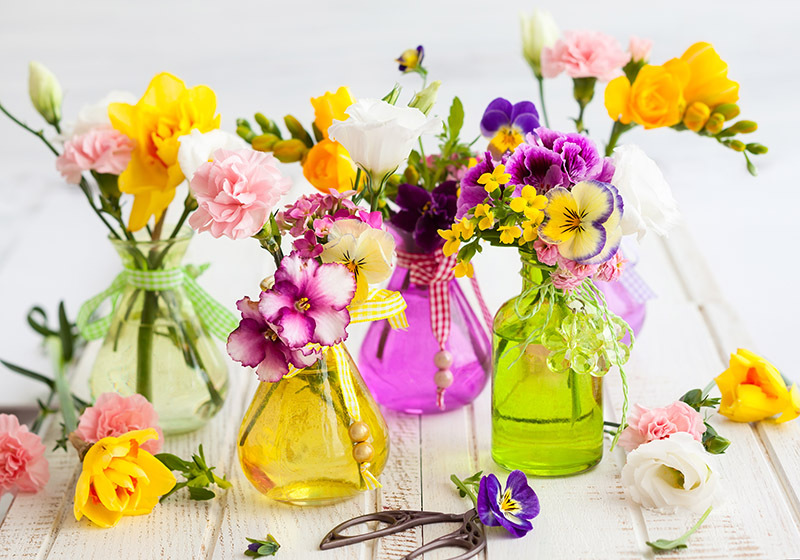Three Hassle-Free Strategies for Fresh Blooms
Posted on 22/08/2025
Three Hassle-Free Strategies for Fresh Blooms
Every flower lover dreams of enjoying fresh blooms with minimal effort--whether in a flourishing garden, a vase brightening up a room, or around the patio. However, ensuring that your blooms stay vibrant, healthy, and long-lasting can be tricky for even the most seasoned plant enthusiasts. If you're searching for straightforward, effective techniques, you've come to the right place.
In this comprehensive guide, we'll reveal three hassle-free strategies for fresh blooms that anyone--regardless of gardening skill--can implement. These proven methods are designed to promote healthier plants, extend the life of cut flowers, and encourage continual blossoming throughout the season. Ready to transform your flowers and home with effortless beauty? Let's get started.
1. Choose the Right Flowers and Maintain Optimal Conditions
The foundation of achieving vibrant, fresh blooms begins with making wise choices about what to grow or buy, paired with the correct growing conditions. This first strategy focuses on selection and environment, two factors that profoundly influence flower health and longevity.
1.1 Select Disease-Resistant and Low-Maintenance Varieties
Some flowers are naturally hardier and easier to care for than others. Choosing tough, disease-resistant varieties ensures the lowest maintenance and best rewards.
- Zinnias: These colorful annuals are drought-resistant and bloom continuously from spring through fall.
- Marigolds: Renowned for pest-repelling properties, marigolds thrive with little fuss and produce sunny, cheerful flowers.
- Sunflowers: Easy to grow from seed, sunflowers require minimal tending once established and deliver a dramatic display.
- Daisies: Hardy perennials such as Shasta daisies withstand variable conditions and bloom reliably each year.
For indoor arrangements, choose hearty blooms like carnations, chrysanthemums, orchids, and lilies for longer-lasting bouquets.
1.2 Optimize Light, Water, and Soil Quality
Understanding the basic needs of your flowers will significantly extend their freshness. Here's how you can easily create optimal growing conditions:
- Sunlight: Most flowering plants need at least 6 hours of sunlight per day. Place garden beds or planters in sun-drenched spots, and for vases, avoid direct intense sunlight that can speed up wilting.
- Watering: Over- or under-watering is a common culprit in flower failure. Most blooms prefer moist--but not soaked--soil. Use a finger test to assess moisture; water when the top inch feels dry. For cut flowers, change the vase water every two days.
- Soil: Rich, well-draining soil reduces stress for flowers. Mix compost or organic matter into garden beds, or purchase quality potting mix for container flowers.
Pro Tip: Avoid crowding when planting. Good air circulation prevents fungal disease and allows each plant sufficient nutrients.

2. Master Simple Maintenance Techniques for Peak Blooms
Once you've selected robust flowers and set the stage with optimal conditions, ongoing care becomes essential for maintaining fresh and beautiful blooms. Fortunately, a few straightforward maintenance routines can work wonders.
2.1 Regular Deadheading and Pruning
Deadheading--removing spent or faded flowers--encourages plants to focus energy on producing new buds. This easy practice increases the quantity and quality of blooms throughout the season.
- Pinch or snip off dead flowers just above a healthy leaf or bud.
- For large, woody perennials, prune back after the main blooming period to stimulate future flowers.
- Regularly removing debris and faded leaves keeps plants healthy and reduces the chance of disease.
Quick tip: Deadhead your flowers weekly, especially annuals like petunias and pansies, for continuous blossoming.
2.2 Strategic Fertilization and Mulching
Feeding your plants and protecting the soil are critical for sustained bloom vitality. Here's how you can fertilize and mulch with minimal effort:
- Use a balanced, slow-release fertilizer at planting time. Too much fertilizer can burn tender plants; start small and observe.
- Mulch around base of plants. A 2-inch layer of organic mulch (like shredded bark or straw) preserves moisture, regulates soil temperature, and prevents weed growth.
- For container plants, use liquid plant food every few weeks when watering for optimal performance.
Fertilizer Tip: Look for "bloom booster" labels on fertilizers. These mixes have extra phosphorus, which supports abundant flowering.
2.3 Pest and Disease Prevention - The Easy Way
Keeping flowers healthy doesn't mean constant vigilance or chemical sprays. There are several low-effort and eco-friendly ways to minimize common threats:
- Plant companions: Certain plants deter pests. Pair marigolds or garlic near susceptible flowers.
- Water early in the day: This ensures leaves dry out before evening, reducing fungus risk.
- Remove diseased parts promptly: At the first sign of mildew or spots, cut away affected areas.
*Natural pest repellents* such as insecticidal soap or neem oil can be used only as needed, ensuring healthy fresh blooms without the hassle.
3. Expert Tricks for Extending the Life of Cut Flowers
Whether you're growing your own or receiving a beautiful bouquet, the real challenge is prolonging the life of fresh-cut blooms. Thankfully, a handful of expert techniques--easy to apply at home--can keep arrangements looking lovely for days, even weeks.
3.1 The Perfect Cut: Timing and Technique
- Cut in the morning: Flowers are most hydrated early in the day, which helps them withstand the shock of being cut.
- Use sharp, clean scissors or pruners: This avoids crushing the stems and allows better water uptake.
- Cut at an angle: Create a larger water-absorbing surface and reduce stem suffocation at the bottom of the vase.
- Remove lower leaves: Leaves below the waterline can rot, leading to bacteria growth and shorter vase life.
3.2 Keep Water and Vases Spotless
Cleanliness is crucial for maintaining fresh flowers in any arrangement. Bacteria quickly build up in stagnant water, causing stems to rot and flowers to wilt.
- Scrub vases with hot soapy water before each use.
- Change water every other day, rinsing stems each time.
- Add a few drops of bleach or commercial floral preservative to vase water. This deters bacteria and fungi growth.
Home remedy: Add a teaspoon of sugar and two teaspoons of white vinegar to the water. Sugar feeds the flowers; vinegar keeps bacteria at bay.
3.3 Location, Placement, and Prolonging Tips
- Keep flowers out of direct sunlight indoors--bright but indirect light is best. Heat causes wilting!
- Avoid placing near fruit bowls. Ripening fruit emits ethylene gas, which dramatically shortens the life of cut flowers.
- Remove faded blooms immediately to prevent molding and encourage remaining flowers to last longer.
- Cool overnight: If possible, store arrangements in a cooler room or even in the refrigerator overnight.
Bonus: Hassle-Free Tools and Supplies for Fresh Blooms
Make your flower care even easier with a few must-have supplies:
- Self-watering pots: Reduce watering chores and keep soil moisture consistent.
- Sharp pruners: Invest in quality garden scissors or snips for healthier cuts.
- Mulch mats: Suppress weeds and retain soil moisture with biodegradable mats.
- Liquid plant food: Bottled mixes for instant boost, especially for container plants or sudden bloom boosts.
- Floral preservatives: Ideal for keeping cut arrangements fresh longer.

Frequently Asked Questions about Hassle-Free Fresh Blooms
How can I keep my fresh flowers blooming longer indoors?
Change water regularly, cut stems at an angle, keep the vase clean, and avoid direct sunlight or heat sources. Add a floral preservative or an easy home mix of vinegar and sugar to nourish and protect your arrangement.
What is the easiest flower to care for in a low-maintenance garden?
Marigolds, zinnias, and daisies are among the simplest. These require little more than occasional watering and benefit from regular deadheading.
Can I use household products to keep cut flowers fresh?
Yes! Sugar, vinegar, bleach, and even aspirin can extend vase life by feeding flowers and controlling bacteria. Just don't overdo it--moderation is key.
How often should I fertilize flowering plants for best blooms?
Apply a balanced, slow-release fertilizer once per growing season for most perennials and annuals; occasional liquid fertilizer works wonders for fast-growing and container plants.
Conclusion: Flourish with Effortless Fresh Blooms
Enjoying fresh, vibrant blooms doesn't require complicated routines or a green thumb. By selecting resilient flowers, optimizing their environment, practicing simple maintenance, and employing easy tricks for cut arrangements, you'll maximize the life and beauty of your blossoms--indoors and out.
Try these three hassle-free strategies for fresh blooms today, and watch your flowers transform with minimal stress and maximum reward!
For more tips on flowers, gardening, and floral arrangement, stay tuned to our blog--your definitive resource for vibrant, easy-care blooms all year long.
Latest Posts
Three Hassle-Free Strategies for Fresh Blooms
Caring for Hydrangeas with Confidence: Tips and Tricks
Red Roses on Valentine's: A Testament to Lasting Love
Brighten Your Workspace with 10 Effortless Office Plants
Journey into the Meaning of Your Birth Flower and Its Impact on You





